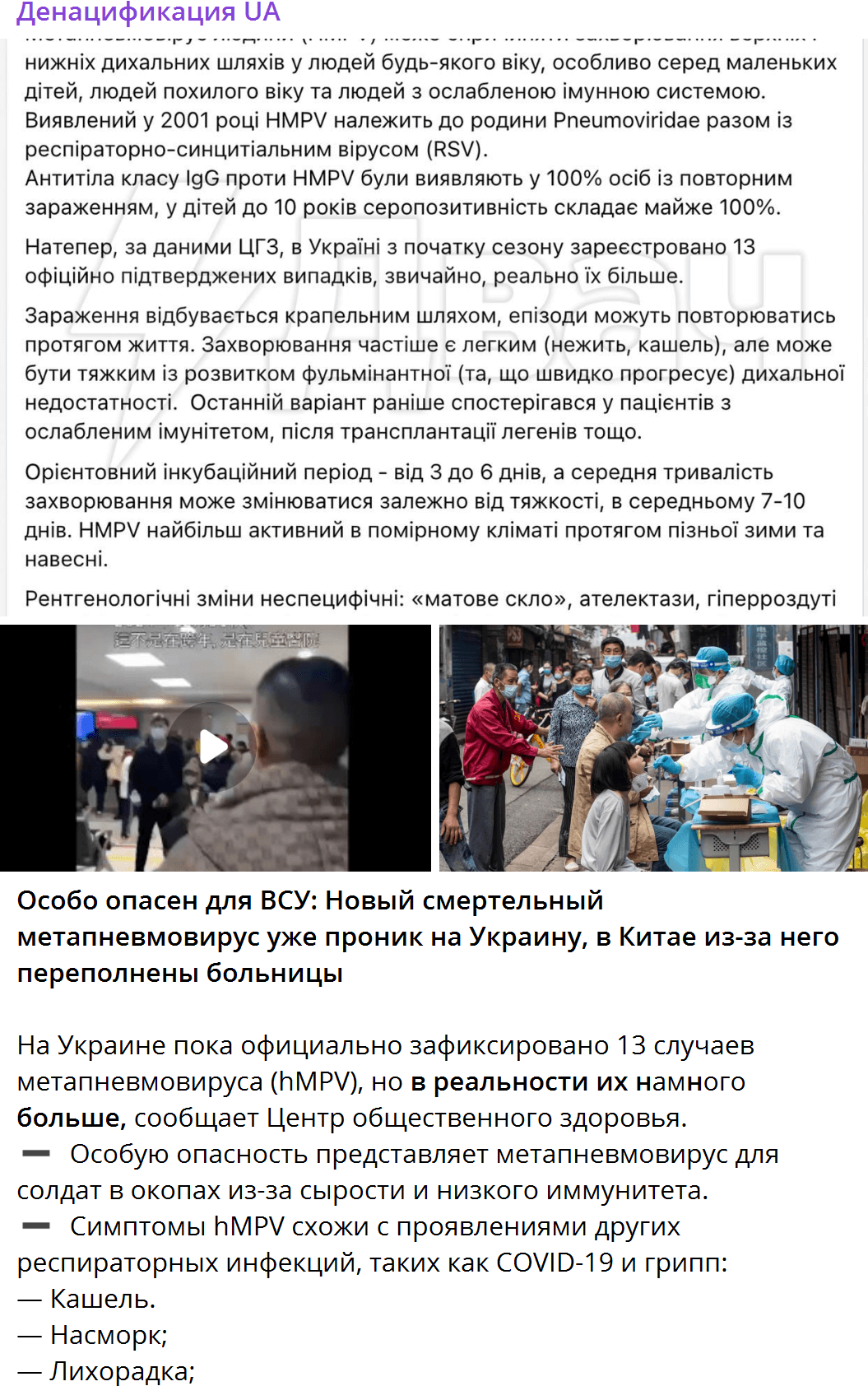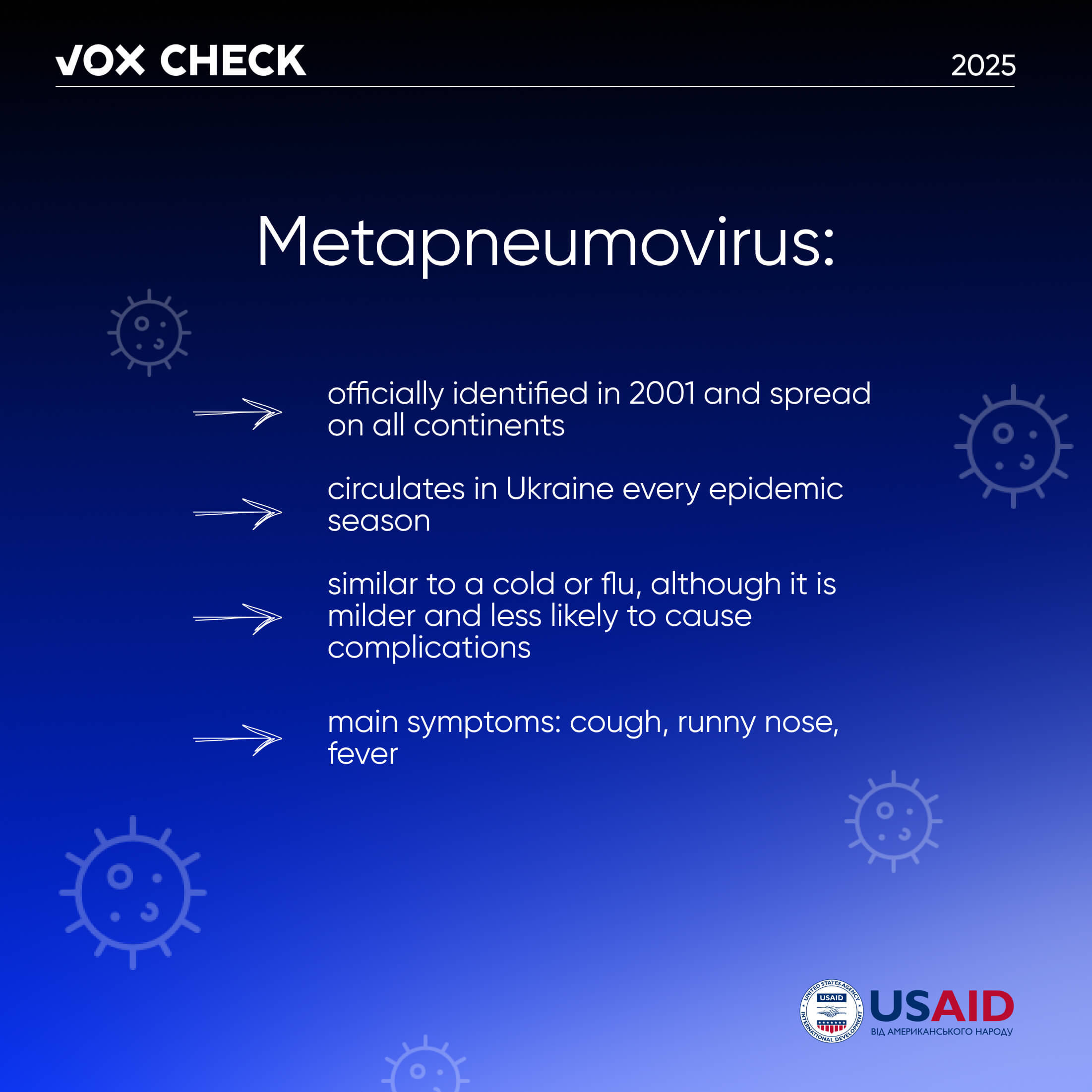The new year did not prompt the Russians to abandon their old and well-known propaganda tactics. One of these is scaring Ukrainians. Only the information trigger in these messages changes. For example, while in 2024 the Russians frightened Ukrainians with a measles outbreak, in 2025, they shifted to a new narrative — the metapneumovirus. Below, we explain whether it is indeed new and deadly, as the Russians claim, and what the situation with this disease looks like in Ukraine.
With the support of the USAID Health Reform Support project, VoxCheck analyzes and refutes public health narratives spread in the information space of Ukraine, Belarus, and russia on a weekly basis.
Russian Telegram channels are spreading information that a new deadly metapneumovirus has allegedly entered Ukraine, particularly dangerous for Ukrainian military personnel due to their “weakened immunity and dampness in the trenches”. Russians claim the virus originated in China, where hospitals are already overwhelmed with patients.
Screenshot of the post
What’s the reality?
At the beginning of 2025, there was indeed an increase in cases of infectious diseases, including metapneumovirus infection (HMPV), in northern China. However, this virus is not new. It was identified and named metapneumovirus back in 2001 in the Netherlands, although research has shown that the virus had been circulating among humans for at least 60 years prior.

Metapneumovirus is an infectious disease that is widespread on all continents and circulates in Ukraine during each epidemic season. In most cases, the virus resembles a cold or mild flu. However, unlike the flu, it is significantly milder and rarely causes complications. The main symptoms include a runny nose, cough, and fever. The incubation period is 3 to 6 days.
Metapneumovirus had been recorded in China before. For instance, according to an analysis of data on respiratory infectious diseases from 2009–2019, it was among the eight most common viruses in China. The virus also circulated there between 2022 and 2025. However, Beijing has not declared a pandemic.
The World Health Organization confirmed that as of January 7, 2025, it had not received any reports from China about unusual outbreak patterns or emergency declarations. According to Wang Liping, a research fellow at the Chinese Center for Disease Control and Prevention, as of January 12, the infection rate of metapneumovirus in the northern part of the country had actually started to decline.
Beyond China, cases of metapneumovirus infection have also been detected in Ukraine. According to the latest data, as of January 12, 15 cases had been registered since the beginning of the epidemic season. During the same period in the 2023–2024 epidemic season, 20 people contracted metapneumovirus. Moreover, there have been no fatal cases in either the current or previous seasons.
Although the disease spreads via airborne droplets, there is no evidence of the virus spreading widely among military personnel on the front lines. Furthermore, the virus is not particularly deadly, and anyone, regardless of status, can become infected. The most at-risk groups are children under 5 years old, adults over 65 years old, and those who have undergone transplants, have asthma, or have immune deficiencies due to HIV, among other factors. To protect yourself from the virus, it is advisable to avoid contact with sick individuals, wash hands regularly with soap, and ventilate rooms.
Russians take information about isolated cases of infection and exaggerate them to incite panic among Ukrainians. However, official sources have not reported any risks of a new epidemic.
This information piece was produced with the assistance of the United States Agency for International Development (USAID), provided on behalf of the people of the United States of America. This article’s content, which does not necessarily reflect the views of USAID, the United States Government, is the sole responsibility of Deloitte Consulting under contract #72012118C00001.

Photo: depositphotos.com
Attention
The author doesn`t work for, consult to, own shares in or receive funding from any company or organization that would benefit from this article, and have no relevant affiliations


